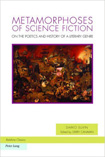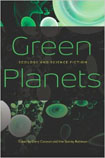Science Fiction and the Hyperobjects
Steve Shaviro: Science fiction is one of the best tools we have for making sense of hyperbolic situations like these. Both in its large-scale world-building and in its small-scale attention to the particular ways in which social and technical innovations affect our lives, science fiction comes to grips with abstractions like economies, social formations, technological infrastructures, and climate perturbations. These are what the ecocritic Timothy Morton calls hyperobjects: entities that are perfectly real in and of themselves, but that are so out of scale with regard to our immediate experience that we find them almost impossible to grasp. The effects of hyperobjects are so massive, and so widely distributed across time and space, that we cannot apprehend them directly. We never experience any particular moment as the one in which climate change, or technological change, actually happens. Either these changes are incipient, just on the verge of happening, or else they have happened already, before we were able to notice. Global capitalism, like global warming, is altogether actual, and yet oddly impalpable: its traces are everywhere, and yet it is never before us as a whole at any given moment or in any given place. A hyperobject lies so far beyond the limits of our senses that it cannot be understood intuitively, but only abstractly. We may model such an object mathematically and computationally; or else we may encapsulate it in the form of a story. One of the great virtues of science fiction in particular is that it works as a kind of focusing device, allowing us to feel the effects of these hyperobjects — of digital technology, or capitalism, or climate change—intimately and viscerally, on a human and personal scale, contained within the boundaries of a finite narrative. Science fiction is, among other things, a form of psycho-socio-technological cartography. It engages in the process of what theorists have called “cognitive mapping” (Fredric Jameson) and “affective mapping” ( Jonathan Flatley). It traces our place alongside, and within, these hyperobjects that threaten to overwhelm us. Via the man himself.










Leave a comment